Section 1 Subsystems
Memory -
Memory performance is very important on a motherboard, especially when you have a CPU with multiple cores and threads. If you have slow memory your cores and threads can become starved for data to execute. To test memory performance we run both Sisoft’s SANDRA and AIDA64. These two combine to not only give us accurate numbers but to validate each other. For testing at stock speeds the memory is hard set to 1333MHz while overclocking testing is done at the highest stable speed for the voltage of 1.65v this is due to the different memory dividers for each CPU. As such, the memory speeds will vary greatly. This means that the overclocked numbers are a little misleading and while they can show a trend are really only included to show if a board has a problem with memory performance at high clockspeeds.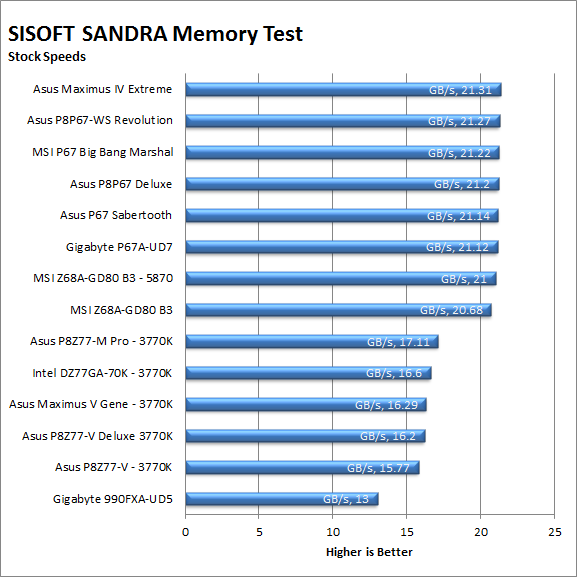
The Asus P8Z77-V Deluxe falls into line with the other Z77 based boards running our 3770K. It is not the fastest of the group, but it is also not far behind. Still the memory performance we see here should help the P8Z77-V Deluxe (we will call it the –V Deluxe moving forward) get through most of our tests without any issues.
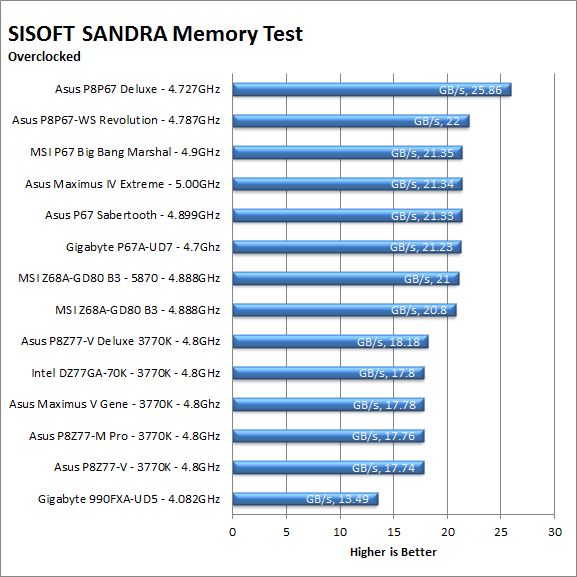
Drive performance -
Drive performance is also one of the major subsystems that goes to make up the performance of a motherboard. For our testing we use Sandra and AIDA64 again. We only test with single drives for each type of controller present on the motherboard (unless it is a professional product where we will use RIAD 5 and/or 10). We have also begun using a Seagate PS-110 USB 3 external HDD and a Kingston HyperX USB 3.0 Flash drive for our USB 3.0 performance. As a side note, we include the overclocked numbers here to make sure (again) that you are not going to see a major drop in performance due to minor instabilities at high clock speeds.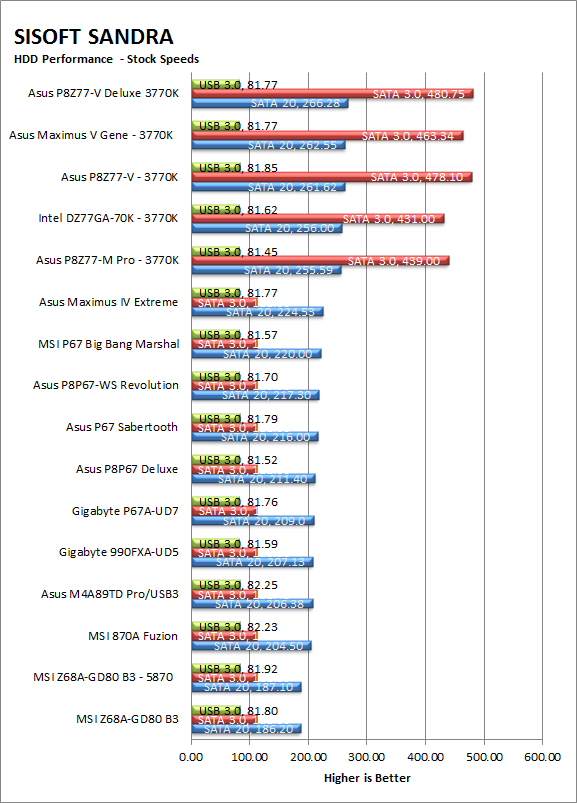
Under our stock run for drive testing we found that the –V Deluxe was at the top of the pile with a SATA 2.0 speed of 266.28 and a SATA 3.0 speed of 480.75. This should help with tasks like transcoding, image manipulation, application installation and loading as well as a few other tasks that require fast access to storage. 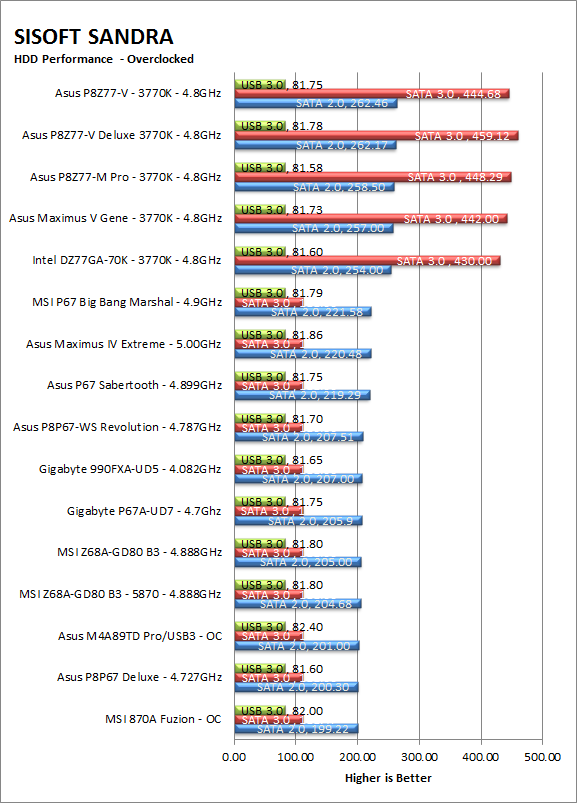
For USB 3.0 performance the –V Deluxe also has the USB 3.0 Boost and with this running we saw performance gains of up to 70MB/s with our Kingston DataTraveler Hyper X (from 254.10 to 275.4). This makes it faster than what we can get from an SSD on the SATA 2.0 controller!
Power -
Power efficiency is another of those misnomers that we get caught up in. We hear about idle states and power gates. But what does that mean to you and I? On the surface having power management that reduces idle power sounds great and can be a benefit to someone that leaves their system on for long periods of time (and inactive) but how a system handles power under load and the delta between the two states is often more important than the idle power usage numbers. We use only P3 Kill A Watt instruments for measuring power. 
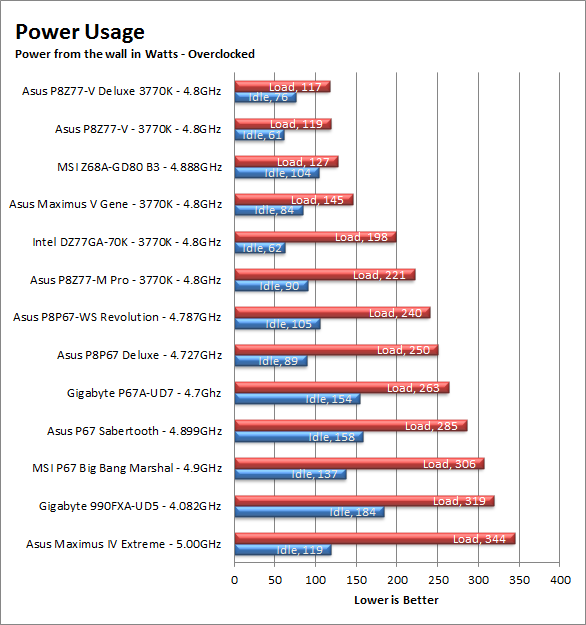
The power draw on the P8Z77-V Deluxe with everything installed (WiFi etc.) and just the 3770k in the motherboard pulls mere 115 Watts under load. This is not bad at all considering what is on the board. When overclocked we only saw a 2Watt jump in power draw under the same set of load conditions. However, once we dropped in the Asus EAH5870 V.2 we saw the efficiency drop quite a bit with load draws of 231 and 263 for stock and overclocked performance.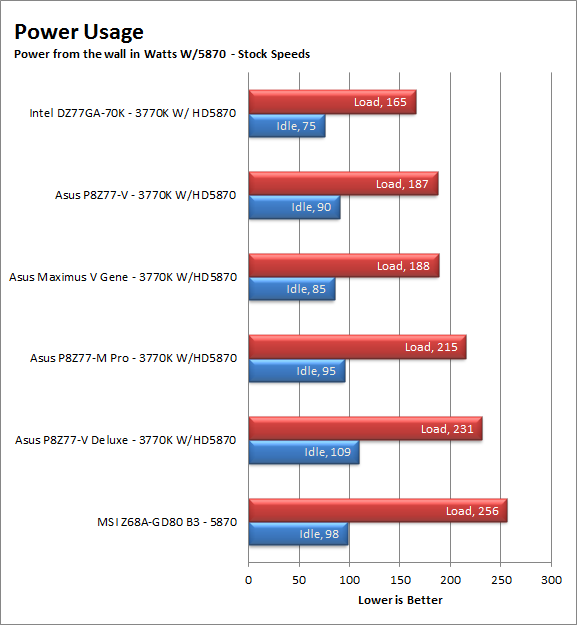
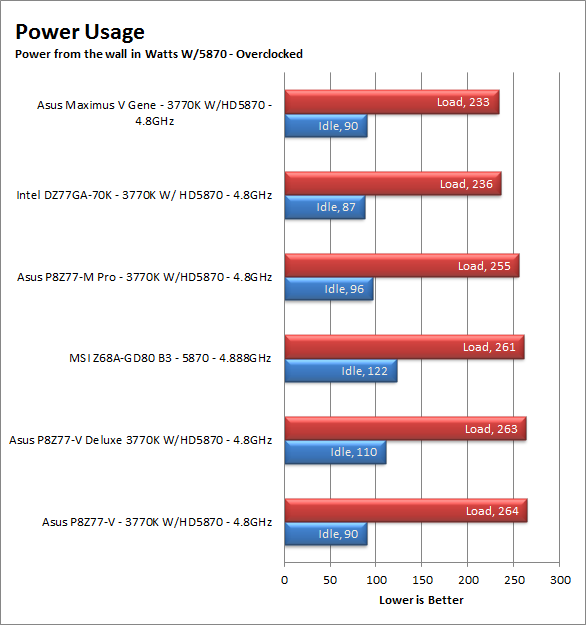
Cooling (Board Level) -
Board level cooling is an important factor in product performance and longevity. Components like the chipset, VRM modules and even capacitors need to be kept relatively cool to prevent failure. As these parts are made of silicon, they have a thermal breakdown threshold; or melting point. At that temperature the actual transistors built into chip will begin to deform and break down. Granted, the threshold is often very high, but you still need to make sure that components stay away from this level of heat for longer product life. 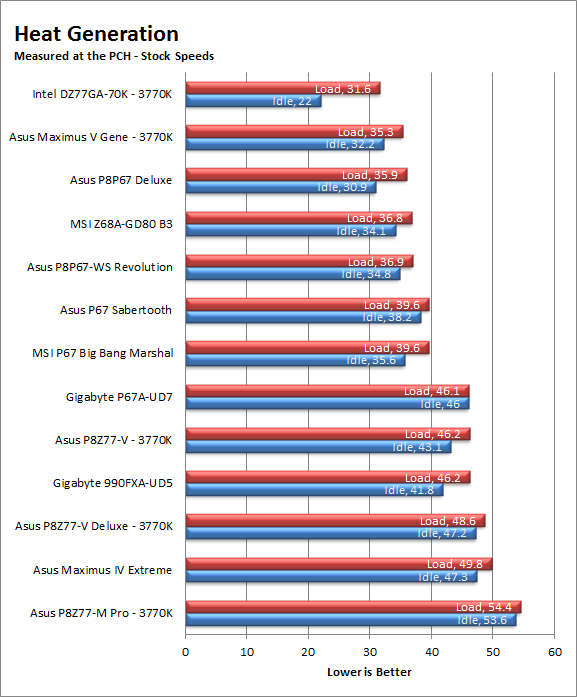
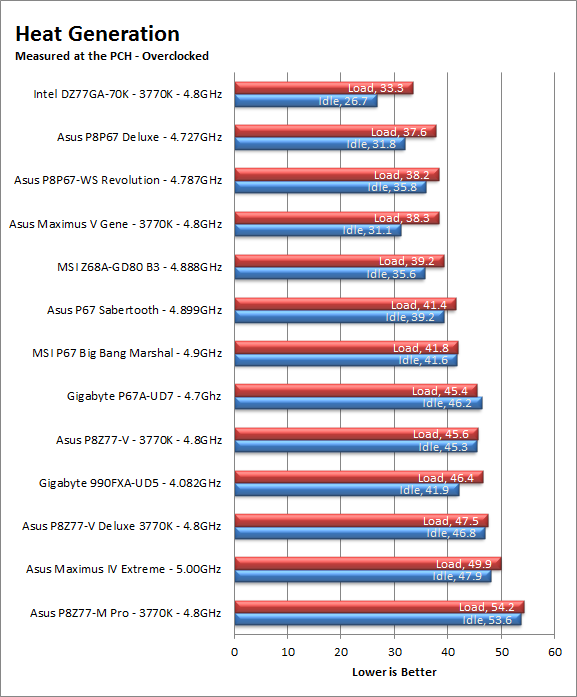
The P8Z77-V Deluxe ran hotter than we thought it would It was even a couple of degrees above the –v. This could be due to the extra components putting a bigger strain on the PCH, but not matter what the cause it is something that you will want to keep an eye on. 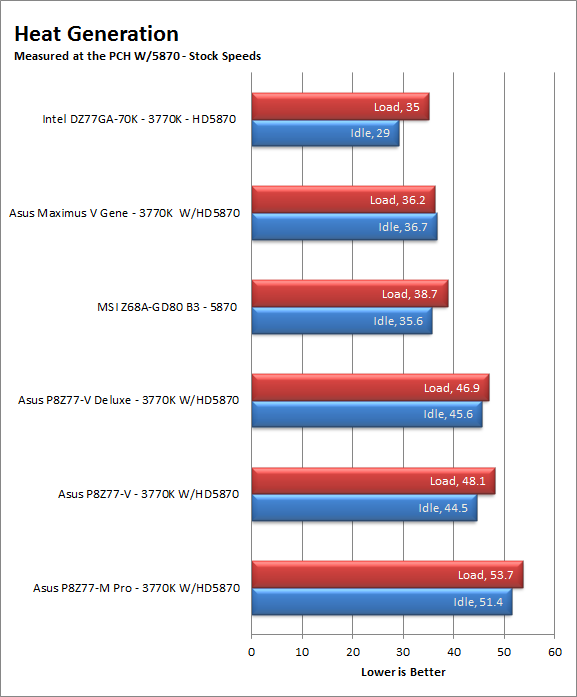
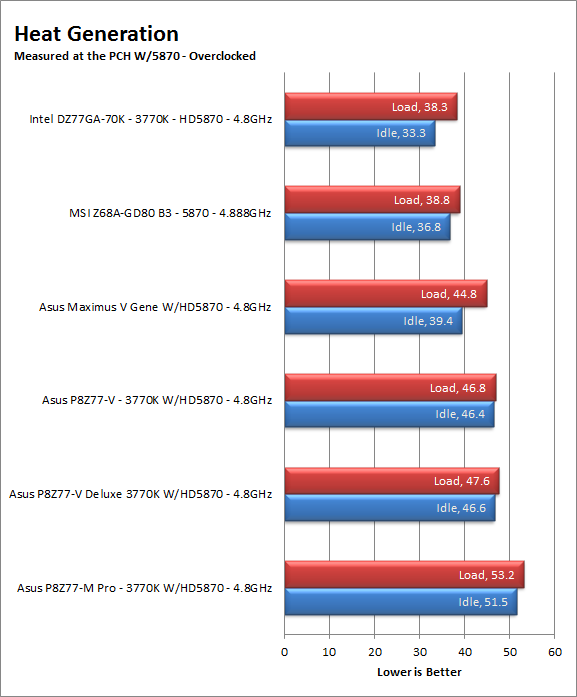
Audio -
Audio is highly subjective. What we find pleasing may sound “off” to you. That is always going to the problem with testing audio; results will vary too widely depending on the tastes of the listener. However, there are ways of measuring the audio output with an objective ear. There is also the issue of audio causing performance issues in gaming and video playback. The reason this is a potential source of concern is that all onboard audio CODECs (Compression/Decompression) are CPU controlled. This means that while the audio chip controls the audio levels and effects of the audio the actual work is done on the CPU. Usually this will not be a problem with today’s powerful CPUs. Even the lower and consumer level products can handle high-end audio these days. But again there is the chance that a bad design or software will hinder your system and performance. On the other side the limits of board space, cost, etc will also prevent the level of audio quality you can get from an add-in board. We test all audio parts with three media types, Movie (DVD), MP3 Music, and Gaming. These are pushed to our Tec On model 55 Tube Amp to see if we can detect any signal issues in the reproduction.
The audio on the –V Deluxe is pretty solid with the dts Connect and dts UltraPC II adding to the audio quality in noticeable ways. This is not award winning audio, but it is better than the typical “good enough” audio that we have seen on more than a few motherboards. On the model 55 we did notice a little bit of tin at the upper end. This was almost like a vibration more than an actual sound and only appeared when there were sustained high frequency sounds (like metal scraping).
Networking -
This one is something that is a requirement anymore. If you have a computer, the chances are good (like 99%) that you are also connected to high-speed internet. With this you need a good and solid LAN chip to make sure that your data flows properly out and back.
The Intel LAN combined with Asus’ new iConnect QoS software makes for a very quick internet connection as long as you have your profile setup correctly. The software is exceptionally easy to use and allows you to setup multiple profiles depending on what you are doing. You can also setup a schedule so that during certain times of the day applications can get priority. This makes it very flexible as we mentioned there was a noticeable improvement in applications that we gave high priority to. (while running other network intensive applications).

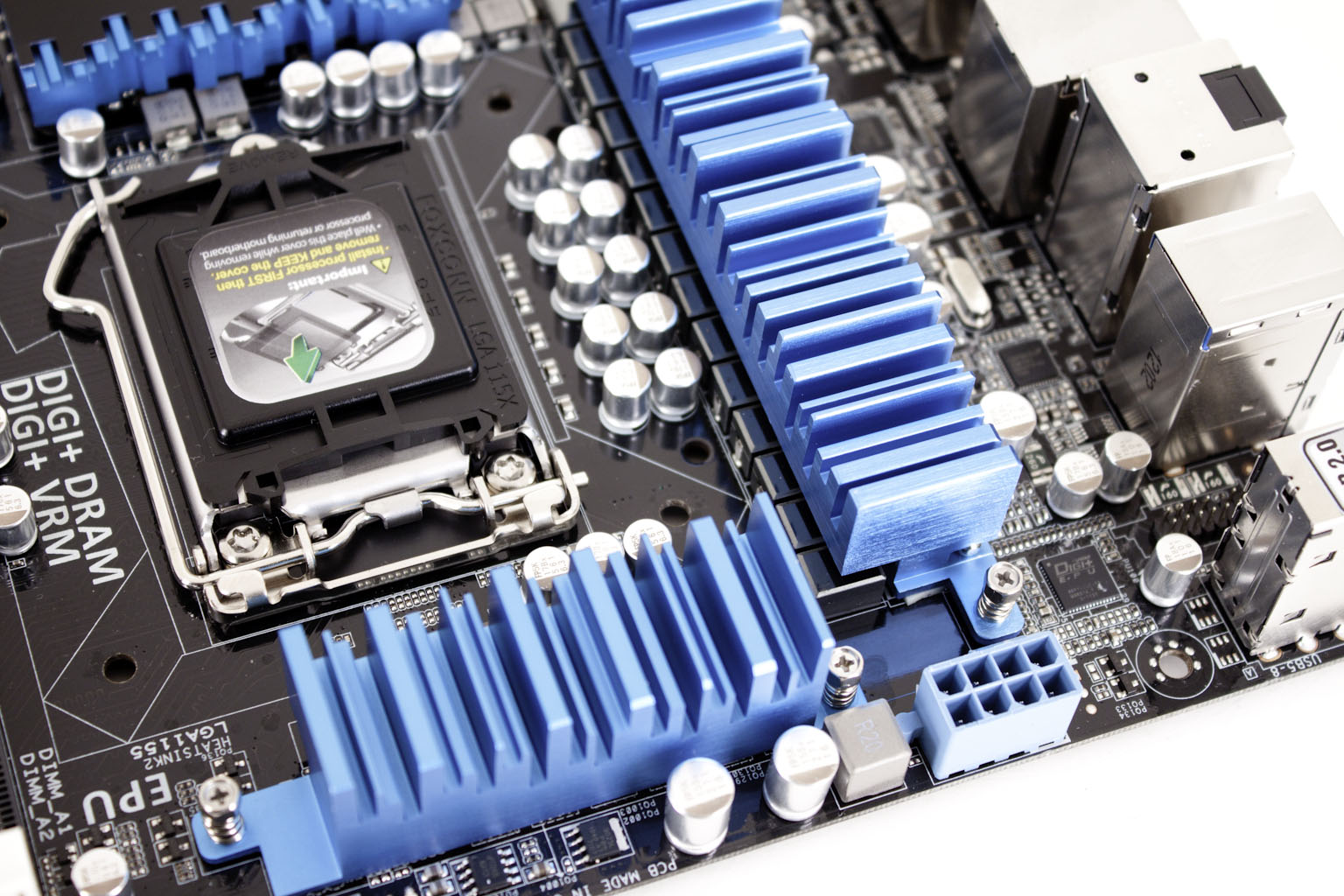 After what seemed like a long time we are finally getting into the full performance section of our review. The Asus P8Z77-V Deluxe is a board that really has quite a bit going on which makes properly covering everything something of a chore. You can check out our
After what seemed like a long time we are finally getting into the full performance section of our review. The Asus P8Z77-V Deluxe is a board that really has quite a bit going on which makes properly covering everything something of a chore. You can check out our 

